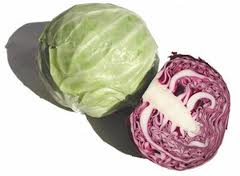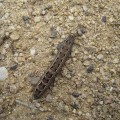[Intro text]
Botanical Information
Taxonomy
- Brassica oleracea
- Capitata Group
- member of Brassicaceae, the Mustard Family
- Related to Collards, Broccoli Raab, Broccoli Rapini (GV)
History
Physical Description
- annual
- Roots go down 12″ to 5′, with the plant reaching 12″ to 15″ tall, 24″ to 40 ” wide
Seasonality
- Cabbage takes a long time to mature, so it uses up a lot of space in the garden (GV)
- For a continuous harvest, sow the different types successively through the year
Spring Cabbages
- Sow in summer; transplant in fall; harvest in spring (GV)
Summer or Fall Cabbages
- Sow in spring & summer; transplant in spring & summer; harvest in summer & fall. (GV)
- start undercover at the beginning of spring for an early harvest of summer cabbages (GV)
Winter Cabbages
- Sow in spring & summer; transplant in summer; harvest in winter (GV)
Red Cabbages
- Sow in spring; transplant in spring & summer; harvest in summer & fall (GV)
Varieties & Cultivars
Categories or Types of Cabbages
Cabbage is classified according to its harvest time:
Spring & Summer Cabbages
- Usually smaller and is eaten right after picking (GV)
- smaller cabbages, earlier to mature, tastiest, juiciest, most tender, but store poorly & split easily
- Mid-season varieties keep better in the field
Fall & Winter Cabbages
- denser cabbage heads; can be left in the ground for longer; can be stored (GV)
- winter cabbages are frost hardy and slow to bolt (GV)
- late varieties, best for sauerkraut, provide the largest and longest-keeping cabbages.
Colors Available
Yellow
- yellow varieties tend to be hotter than white
Green
White
- white varieties tend not to be as hot as yellow
Purple
Red
Varieties (link to ../category/cultivars/tag/[plantname])
Growth Requirements
Climate & Temperature Requirements
For Germination
- 45-95 degrees F
For Growth
- 60-65 degrees F
- cool-season crop, hardy to frost and light freezes
- young plants may bolt if grown at 50 degrees F for a long time
- late varieties get improved flavor in cold weather
Humidity
Day Length or Light Requirements
Site Conditions Favored
- Cabbages don’t mind fall sun or partial shade (GV)
- Cabbages are space hogs, and they take a long time to mature; for crop rotation, grow cabbages in a space that hasn’t had cabbages for at least 3 years. (GV)
Soil Requirements
Soil Texture
- cabbages like fertile soil that retains moisture (GV)
- soil must be firm for the roots to support a heavy head of cabbage; if soil is light and sandy, add compost or manure during the previous season to improve firmness (GV)
pH
- pH should be slightly alkaline to discourage club root; at least 6.8 (GV)
- pH: 6.0-7.5 (7.2 deters clubroot) add lime to raise pH
Nutrient Requirements
- cabbages like fertile soil that retains moisture (GV)
- Cabbage is a heavy feeder; high N, high K
Propagation
Methods of propagation
Seed
- it’s best to sow cabbage seeds in trays, pots, or modules, then transplant them into their final position once established. Sow thinly and cover with potting soil 3/4″ deep. (GV)
- sow seeds 1/4″-1/2″ (A-Z)
- Start seeds 63-75 days before last frost date (A-Z)
- Germination: 7-12 days (A-Z)
- you can succession sow cabbage seeds all the way up to 104-130 days before first frost date, for a fall harvest. The seeds will germinate quicker, because of the warmer weather (in about 4 days) and they can be transplanted at 21 days (A-Z)
Division
not possible
Cuttings
Transplanting or Potting Up
- transplant at about 42 days after germination (A-Z)
Seed Saving
Planting Out
- once 3 or 4 true leaves have formed, cabbages can be planted out; make sure to water the seedling well, and if you are lifting them from a flat, hold them by the leaves, so the roots don’t get damaged. Keep moist until they are planted. Plant them 6″ deep and gently firm the soil around them. (GV)
Bed Prep & Soil Amendments
Bed Spacing
- space plants 15″ apart in beds
Row Spacing
- 18″ apart in rows that are 24″-30″ apart; plant closer together for smaller heads
Planting Depth
- Make holes 6″ deep, 18″ apart. (GV)
- root depth: 12″ to 5′
Alternative Bed Methods
Container Gardening
Routine Cultivation & Maintenance
Water Requirements
- water cabbage seedlings daily at first, then once or twice per week, but don’t allow them to dry out. (GV)
- water heavy early and medium late in the season
Fertilization Recommendations
- cabbage is a heavy feeder, requiring high N and high K; side-dress every 2 weeks
Mulching & Weeding
Pinching or Pruning & Dividing
- cut off and remove any dead outer leaves. (GV)
Support
- Earth up the stems (push soil up around the stem) to support them as the plant grows its heavy head (GV)
Winterizing
Companion Planting
Helpful Companions
- Artichoke
- Beet
- Bush Beans
- Candytuft
- Celery (uncertain)
- Chamomile (uncertain)
- Clover (red and white)
- Collards
- planting collards around your cabbage will draw Diamond Back Moths away (GV)
- Cucumber
- Dill (uncertain)
- Garlic (uncertain)
- Hyssop (uncertain)
- Lettuce
- Mint (uncertain)
- Mustard
- Nasturtium (uncertain)
- Onion Family (uncertain)
- Peas
- Potato
- Radish (uncertain)
- Rosemary (uncertain)
- Sage (uncertain)
- Savory (uncertain)
- Shepherd’s Purse
- Southernwood (uncertain)
- Spinach
- Tansy (uncertain)
- Thyme (uncertain)
- Tomato (uncertain)
- Wormseed
- Wormwood (uncertain)
Harmful Companions
- Basil
- Pole Beans
- Strawberry
- Tomato
Companion to..
Pests, Diseases & Problems
Control and Prevention
- Crop rotation of 3 years or more, 7 years is optimal
- slightly alkaline soil (7.2), but no lower than 6.8
- nets or floating row covers
- brassica collars
- trap crops of collards
- don’t compost any brassica roots; pull & destroy infected plants
Common Pests of Cabbage
Common Diseases of Cabbage
Symptoms
Whole Plant
- Bolting
- commonly happens if the temperatures rise above 50°F
- Death
Leaves
- holes in leaves
- yellow leaves or yellow patches on leaves
- leaf curl
Heart
- holes in cabbage heart
- cabbage head splits or cracks open
- too much water
- planting cabbages closer together can reduce this
- prevent this by giving the head a sharp twist to sever feeder roots when the head is almost full
- see “Water Requirements“, above
- early varieties (spring & summer cabbages) are more likely to split than fall & winter varieties
- too much water
Stem/Trunk
Flowers
Roots
Harvesting & Storage
Edible Parts of the Plant
- duh…the cabbage head. 🙂
- you can also harvest just the leaves of spring and early summer cabbages in the early part of the season.
Yield
- 1 plant yields 1 head
- plan on growing 3-5 plants per person to feed.
Days to Harvest / Harvest Timing / Harvest Clues
- Once the cabbage has hearted up, you will know it can be picked. GV
- smaller heads taste better than the larger ones A-Z
- for eating fresh, harvest as soon as the head feels solid A-Z
- for harvesting cabbage to store, pick when the head is still firm and solid but before the top leaves lose green color. if left in the ground too long, the cabbage core gets tough and fibrous, and the head has a higher tendency to split A-Z
- The right time to harvest cabbage heads is when they are firm and solid VG
Harvest Methods
- cut off the heads with a sharp knife, or lift the entire plant GV
- if the cabbage head is cut off at ground level, smaller heads may grow from the remaining leaves and stems A-Z
- for harvesting cabbage for storage, pull the entire plant and roots from the ground A-Z
- Pull the entire cabbage head out of the ground. VG
Storage of harvest
Fresh
SPRING & SUMMER CABBAGES
- Spring and Summer cabbages are not keepers; eat them right away (GV)
- After the cabbage is harvested, it continues to grow, so rapid growers (early varieties) keep poorly because they use up their food reserves faster.
FALL & WINTER CABBAGES
- Fall and winter cabbages can be harvested later then stored on shelves or in nets for a few months in a cool place. (GV)
- some sources recommend curing the cabbage heads in the sun for a few days before storing for long periods of time. They must be covered at night, but because of the strong odors that get emitted, they should be stored in a well-ventilated place (A-Z)
Prep
- Trim off all loose outer leaves,
How to Store
- hang by the cabbage plant’s roots (A-Z)
- wrap individually in paper (A-Z)
- layer in straw inside an airy bin (A-Z)
- place on shelves, spaced several inches apart from the next cabbage head. (A-Z)
Temperature
- 32-40 degrees F (A-Z)
Humidity
- 80-90% (A-Z)
Shelf Life
- about 4 months (A-Z)
Canned
Taste: yuck
Shelf Life: ?
Frozen
Taste: good (A-Z)
Shelf Life: 8 months (A-Z)
PICKLED
Taste
Shelf Life
Dried
Taste: fair (A-Z)
Shelf Life: 12+ months (A-Z)
Cooking
Nutritional Benefits & Values
Toxicity
Cooking
Preparation
Cooking Methods
Recipes (link to …/category/recipes/tag/[plantname])
Sources
Information for this article was taken from these sources:



